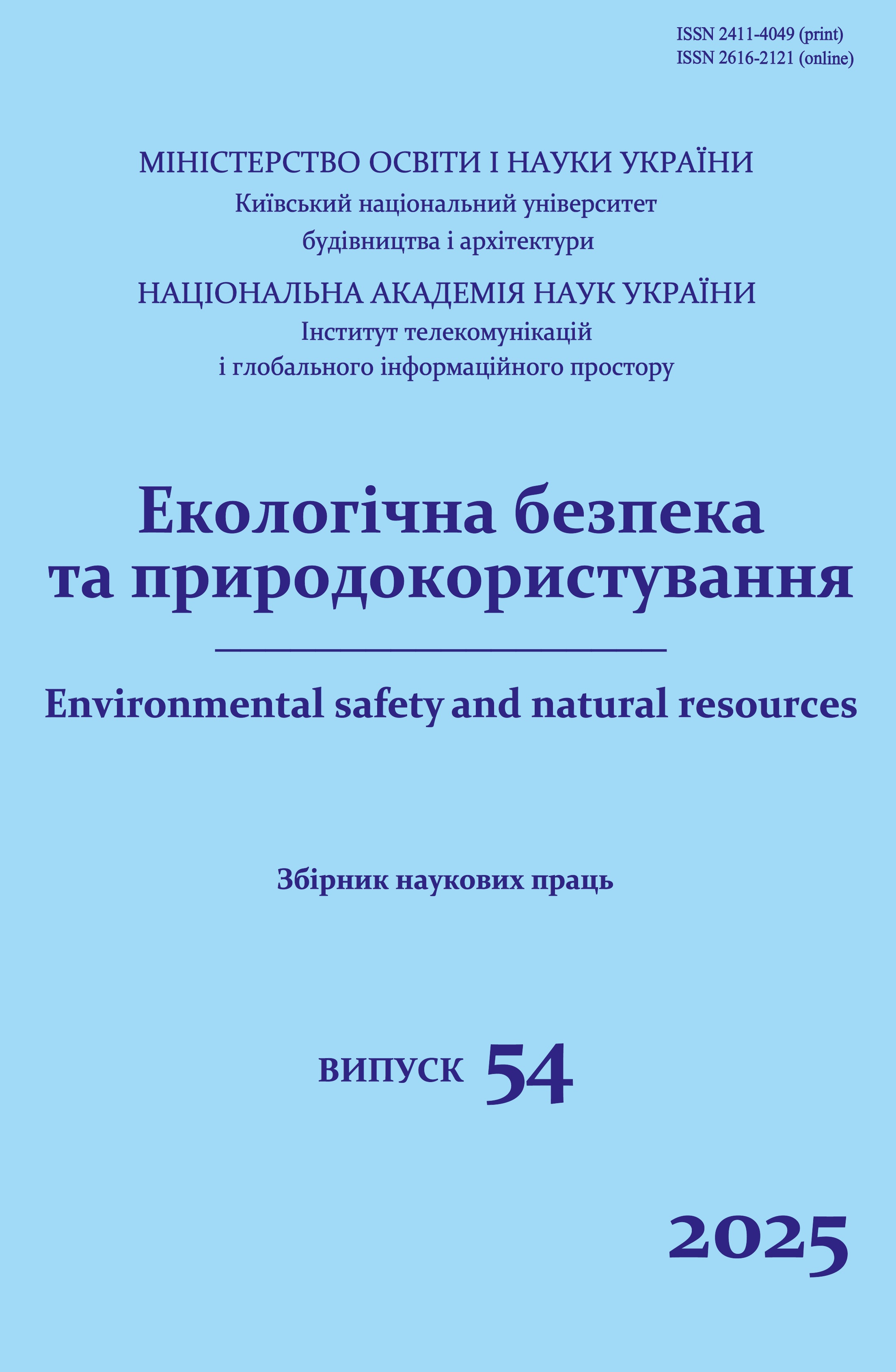Innovative approaches to automation of ship's ballast water treatment and disinfection processes
DOI:
https://doi.org/10.32347/2411-4049.2025.2.51-61Keywords:
ballast water, marine vessels, treatment, disinfection, invasive species, control systemAbstract
This research introduces innovative technology for ship's ballast water treatment and disinfection that meets the International Maritime Organization's D-2 water quality standard requirements. The innovative approach to ballast water processing has been developed and validated by the research team at the Danube Institute of the National University "Odesa Maritime Academy" as part of the state-funded research project No. 0124U004399, supported by the Ministry of Education and Science of Ukraine. Environmental monitoring of the Black Sea, conducted by the international scientific community in 2019, revealed a critical deterioration in the state of the marine ecosystem. Over the five-year observation period, a threefold increase in the level of pollution of the marine environment was recorded. The study emphasizes the critical role of ballast water in modern maritime navigation, particularly its significance for vessel stability and operational safety. However, the presence of numerous marine organisms in ballast water poses significant multidimensional challenges, ranging from threats to ecological balance to economic losses and sanitary-epidemiological risks. The transfer of ballast water between different geographical locations facilitates the invasion of non-indigenous microorganisms into new ecosystems, potentially leading to the destruction of local biota and causing substantial economic losses in coastal regions. The developed experimental facility implements a comprehensive approach to ballast water treatment through the sequential application of chemical, ionization, and mechanical processing methods. A key objective is the creation of an automated control system for the experimental ballast water treatment equipment, designed to ensure precise monitoring of technological parameters and optimize laboratory testing efficiency.
The developed multifunctional ballast water management system is designed for large-tonnage vessels and fully complies with D-2 standard requirements. Experimental studies have confirmed the high efficiency of the proposed technology in eliminating pathogenic microorganisms and purifying ballast water, as documented by laboratory test results. Currently, the system is undergoing type approval and certification procedures in accordance with international standards.
References
Tsolaki, E., & Diamadopoulos, E. (2009). Technologies for ballast water treatment: A review. Journal of Chemical Technology & Biotechnology, 85(1), 19–32. https://doi.org/10.1002/jctb.2276
International Maritime Organization. International Maritime Organization (IMO). https://www.imo.org/ (Accessed October 1, 2024).
Verkhovna Rada of Ukraine. (2004). International Convention for the Control and Management of Ships' Ballast Water and Sediments, 2004. https://zakon.rada.gov.ua/laws/show/896_050#Text (Accessed August 10, 2024).
International Maritime Organization. (2016). Resolution MEPC.279(70). Guidelines for approval of ballast water management systems (G8), 2016. Annex 5 (42 pages). https://wwwcdn.imo.org/localresources/en/KnowledgeCentre/IndexofIMOResolutions/MEPCDocuments/MEPC.279(70).pdf (Accessed October 12, 2024).
Lakshmi, E., Priya, M., & Achari, V. S. (2021). An overview on the treatment of ballast water in ships. Ocean & Coastal Management, 199, 105296. https://doi.org/10.1016/j.ocecoaman.2020.105296
Bailey, S. A., Brydges, T., Casas-Monroy, O., Kydd, J., Linley, R. D., Rozon, R. M., & Darling, J. A. (2022). First evaluation of ballast water management systems on operational ships for minimizing introductions of nonindigenous zooplankton. Marine Pollution Bulletin, 182, 113947. https://doi.org/10.1016/j.marpolbul.2022.113947
David, M., Gollasch, S. (2015). Ballast Water Management Systems for Vessels. Global Maritime Transport and Ballast Water Management. Invading Nature - Springer Series in Invasion Ecology, vol 8. Springer, Dordrecht. https://doi.org/10.1007/978-94-017-9367-4_6
Liu, H. (2023). Study on Ship Ballast Water Treatment Methods. Highlights in Science, Engineering and Technology, 72, 783-787. https://doi.org/10.54097/kyy8mm53
Lakshmi, E., Priya, M., & Achari, V. S. (2021). An overview on the treatment of ballast water in ships. Ocean; Coastal Management, 199, 105296. https://doi.org/10.1016/j.ocecoaman.2020.105296
Yilmaz, M. & Bilgin Güney, C. (2023). Evaluation of ballast water treatment systems from the perspective of expert seafarers' ship experiences. Brodogradnja, 74 (4), 129-154. https://doi.org/10.21278/brod74407
Sun, Y., Zhao, Y., Sheng, S., Wang, Y., & Zhou, H. (2021). Experimental study on photocatalytic treatment of alien organisms in ship ballast water by F/CE–tio2. Journal of The Institution of Engineers (India): Series C, 102(6), 1429–1436. https://doi.org/10.1007/s40032-021-00766-9
Özdemir, Ü. (2022). A quantitative approach to the development of ballast water treatment systems in ships. Ships and Offshore Structures, 18(6), 867–874. https://doi.org/10.1080/17445302.2022.2077544
Outinen, O., Bailey, S. A., Casas-Monroy, O., Delacroix, S., Gorgula, S., Griniene, E., Kakkonen, J. E., & Srebaliene, G. (2024). Biological testing of ships’ ballast water indicates challenges for the implementation of the Ballast Water Management Convention. Frontiers in Marine Science, 11. https://doi.org/10.3389/fmars.2024.1334286
Amidi, R., & Fatemi, S. M. (2024). Investigation and evaluation of risk of pathogen transfer by Ballast Water in Shahid Rajaee Port, Hormozgan Province, Iran. Environmental Monitoring and Assessment, 196(12). https://doi.org/10.1007/s10661-024-13329-z
Zatoń-Sieczka, K., & Czerniejewski, P. (2024). The impact of microorganisms transported in ships’ ballast water on the fish of the estuarine waters and environmental sustainability in the southern Baltic Sea. Sustainability, 16(12), 5229. https://doi.org/10.3390/su16125229
Effendi, I., Ghifari, M. F., Nedi, S., & Effendi, S. (2024). Electrocoagulation system for treatment of Ballast Water. Carpathian Journal of Earth and Environmental Sciences, 19(2), 217–232. https://doi.org/10.26471/cjees/2024/019/293
Downloads
Published
How to Cite
Issue
Section
License
Copyright (c) 2025 Vitalii Zalozh

This work is licensed under a Creative Commons Attribution 4.0 International License.
The journal «Environmental safety and natural resources» works under Creative Commons Attribution 4.0 International (CC BY 4.0).
The licensing policy is compatible with the overwhelming majority of open access and archiving policies.

